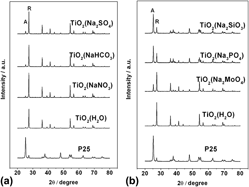Crossref Citations
This article has been cited by the following publications. This list is generated based on data provided by
Crossref.
Ma, Yi
Wang, Xiuli
Jia, Yushuai
Chen, Xiaobo
Han, Hongxian
and
Li, Can
2014.
Titanium Dioxide-Based Nanomaterials for Photocatalytic Fuel Generations.
Chemical Reviews,
Vol. 114,
Issue. 19,
p.
9987.
Xia, Ting
Zhang, Chi
Oyler, Nathan A.
and
Chen, Xiaobo
2014.
Enhancing microwave absorption of TiO2 nanocrystals via hydrogenation.
Journal of Materials Research,
Vol. 29,
Issue. 18,
p.
2198.
Sang, Lixia
Zhao, Yixin
and
Burda, Clemens
2014.
TiO2Nanoparticles as Functional Building Blocks.
Chemical Reviews,
Vol. 114,
Issue. 19,
p.
9283.
Shang, Cheng
Zhao, Wei-Na
and
Liu, Zhi-Pan
2015.
Searching for new TiO2crystal phases with better photoactivity.
Journal of Physics: Condensed Matter,
Vol. 27,
Issue. 13,
p.
134203.
Ma, Yi
Wang, Xiuli
and
Li, Can
2015.
Charge separation promoted by phase junctions in photocatalysts.
Chinese Journal of Catalysis,
Vol. 36,
Issue. 9,
p.
1519.
Peng, Rui
Liang, Liangbo
Hood, Zachary D.
Boulesbaa, Abdelaziz
Puretzky, Alexander
Ievlev, Anton V.
Come, Jeremy
Ovchinnikova, Olga S.
Wang, Hui
Ma, Cheng
Chi, Miaofang
Sumpter, Bobby G.
and
Wu, Zili
2016.
In-Plane Heterojunctions Enable Multiphasic Two-Dimensional (2D) MoS2 Nanosheets As Efficient Photocatalysts for Hydrogen Evolution from Water Reduction.
ACS Catalysis,
Vol. 6,
Issue. 10,
p.
6723.
Monai, Matteo
Montini, Tiziano
and
Fornasiero, Paolo
2017.
Brookite: Nothing New under the Sun?.
Catalysts,
Vol. 7,
Issue. 10,
p.
304.
Wang, Xiuli
and
Li, Can
2018.
Roles of Phase Junction in Photocatalysis and Photoelectrocatalysis.
The Journal of Physical Chemistry C,
Vol. 122,
Issue. 37,
p.
21083.
Wang, Zihao
Wang, Yilan
Zhang, Wan
Wang, Zenglin
Ma, Yi
and
Zhou, Xin
2019.
Fabrication of TiO2(B)/Anatase Heterophase Junctions at High Temperature via Stabilizing the Surface of TiO2(B) for Enhanced Photocatalytic Activity.
The Journal of Physical Chemistry C,
Vol. 123,
Issue. 3,
p.
1779.
Yang, Kai
Li, Xiaoxiao
Yu, Changlin
Zeng, Debin
Chen, Fanyun
Zhang, Kailian
Huang, Weiya
and
Ji, Hongbing
2019.
Review on heterophase/homophase junctions for efficient photocatalysis: The case of phase transition construction.
Chinese Journal of Catalysis,
Vol. 40,
Issue. 6,
p.
796.
Su, Yue
Zhang, Wei
Chen, Shanming
Yao, Danwen
Xu, Jilian
Chen, Xiaobo
Liu, Lei
and
Xu, Huailiang
2020.
Engineering black titanium dioxide by femtosecond laser filament.
Applied Surface Science,
Vol. 520,
Issue. ,
p.
146298.
Luna-Sanguino, Gema
Tolosana-Moranchel, Alvaro
Carbajo, Jaime
Pascual, Laura
Rey, Ana
Faraldos, Marisol
and
Bahamonde, Ana
2020.
Role of surrounding crystallization media in TiO2 polymorphs coexistence and the effect on AOPs performance.
Molecular Catalysis,
Vol. 493,
Issue. ,
p.
111059.
Dozzi, Maria Vittoria
and
Selli, Elena
2021.
Titanium Dioxide (Tio₂) and Its Applications.
p.
211.
Gonuguntla, Spandana
Kamesh, Reddi
Pal, Ujjwal
and
Chatterjee, Debabrata
2023.
Dye sensitization of TiO2 relevant to photocatalytic hydrogen generation: Current research trends and prospects.
Journal of Photochemistry and Photobiology C: Photochemistry Reviews,
Vol. 57,
Issue. ,
p.
100621.





